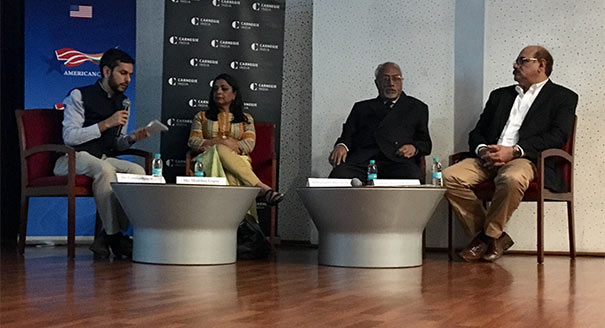Registration
You will receive an email confirming your registration.
In 1990, India conducted the world’s largest civilian airlift to evacuate more than 100,000 members of the Indian diaspora from Kuwait during the Gulf War. In 2016, the Hindi film “Airlift” depicted the evacuation operations. Given the extent of Bollywood’s reach, Airlift can be regarded as an important documentation of one of India’s biggest foreign policy achievements.
As part of a new event series called “Culture, Cinema, and Policy,” Carnegie India, in partnership with the American Center, New Delhi, hosted Ambassador Harish Dogra, Captain Arvind Kathpalia, and Indian Express film critic Shubhra Gupta for a panel discussion on India’s experience with diaspora evacuations. Constantino Xavier moderated the discussion.
Discussion Highlights
- Lack of Historic Authenticity: Participants agreed that the film was crucial in highlighting diaspora evacuation operations. However, they asserted that it overdramatized several elements of the evacuation operation, which made the depiction of events historically inaccurate. They added that most characters, especially the bureaucrats and politicians, were largely misrepresented. The participants also discussed the role of historical accuracy in films. Some participants contended that it should be the filmmaker’s responsibility to portray an accurate account, while others suggested an external regulatory body should ensure authenticity.
- Complexity of Evacuation Operations: Participants also discussed the details of the Kuwait airlift. They said that the Ministry of External Affairs (MEA) and Air India, India’s national carrier, played a critical role in the entire evacuation process. A special coordination unit, they explained, had been established between Kuwait and India to enable the large-scale evacuation. Participants argued that Indian diplomacy had to be especially tactful to convince Iraq to cooperate in facilitating the evacuation. Participants argued that the MEA was working in circumstances with numerous formalities, without adequate communication between stakeholders.
- Role of Air India: Participants asserted that Air India and Indian Airlines played a critical role in the evacuation. They said that the Air India crew on board was initially worried about flying into a war zone. They soon overcame that fear and provided psychological support to traumatized evacuees during the flights, participants said. The participants then discussed Operation Rahat, the evacuation of Indians from Yemen in 2015. Pilots had to operate under highly stressful circumstances like small ceasefire windows negotiated with all warring parties, participants added. Discussants briefly touched upon the emerging plans to privatize Air India, and questioned whether future civilian airlifts might need to involve private airlines.
- Need for Standard Operating Procedures: Participants agreed that the lack of standard evacuation procedures makes the planning of new operations difficult. They argued that India’s past operations should inform the guidelines for future operations. Participants added that operations like Operation Rahat add to New Delhi’s public diplomacy. They recommended that the government frame standard operating procedures, which can then be tweaked for each individual operation in the future.
- Films as Policy Catalysts: Some participants argued that movies, although a source of entertainment can sometimes be the only available public documentation of the event. Panelists mentioned that films have the power to rewrite history and form public opinions about the government and its policies, especially when access to credible sources like government reports is limited. Participants agreed that cinema has sensitized Indians to historical issues and complex challenges of government in foreign policy, economic governance, or science and technology innovation. All participants agreed that films catalyze a broader discussion on key transformations in Indian society.
This event summary was prepared by Simran Sawhney, an intern at Carnegie India.
